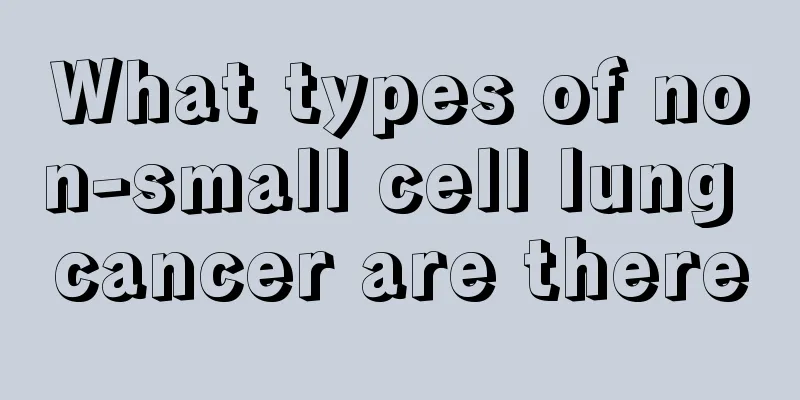What types of non-small cell lung cancer are there

|
Non-small cell lung cancer mainly includes three types: adenocarcinoma, squamous cell carcinoma and large cell carcinoma. These subtypes differ in pathology, pathogenesis and treatment methods, but their treatment is mainly surgery, chemoradiotherapy, targeted therapy and immunotherapy, and the options for different types may be slightly different. 1. Types and characteristics of non-small cell lung cancer 1. Adenocarcinoma: It is the most common type of non-small cell lung cancer, accounting for about 40%-50% of cases, and is more common in non-smoking female patients. Adenocarcinoma often originates in the peripheral parts of the lungs, and early symptoms are hidden, which may be manifested by persistent cough, fatigue, or occasional blood in sputum. 2. Squamous cell carcinoma: It accounts for about 25%-30%, and is often related to smoking. It usually occurs in the central part of the lungs. Squamous cell carcinoma is more likely to cause symptoms such as coughing, sputum and chest pain. It is discovered earlier because it invades the airway earlier. 3. Large cell carcinoma: The incidence rate is relatively low, accounting for 10%-15%. It is characterized by poor cell differentiation and high invasiveness. It is more common in the peripheral parts of the lungs. There may be no obvious symptoms in the early stages and it is easy to spread in the late stages. 2. Different types of treatment options 1. Surgical treatment: For cases with a clear diagnosis and confined to the lungs, surgical resection is the preferred method. Depending on the specific situation, lobectomy, segmentectomy or pneumonectomy can be selected. 2. Chemoradiotherapy: Generally suitable for patients who cannot undergo surgery or for postoperative adjuvant therapy. Squamous cell carcinoma is sensitive to chemoradiotherapy, while large cell carcinoma may require more intensive chemotherapy due to its higher malignancy. 3. Targeted therapy: Mainly used for patients with adenocarcinoma containing specific gene mutations such as EGFR mutation, ALK fusion, etc. Commonly used drugs include gefitinib, erlotinib and osimertinib. 4 Immunotherapy: Drugs such as the PD-1/PD-L1 inhibitor carrelizumab can be used for patients who are unable to undergo surgery and for whom genetic testing has not found effective target mutations. 3. Recommendations for the prevention and treatment of non-small cell lung cancer During treatment, efforts should be made to prevent predisposing factors. Quitting smoking is a key preventive measure, especially for reducing the risk of squamous cell carcinoma. Environmental exposure to carcinogens such as asbestos, uranium, and radon should be reduced, and regular physical examinations should be conducted, especially for high-risk groups such as smokers and those who have long-term exposure to pollutants. Low-dose spiral CT screening is recommended every year. It is very important to distinguish the type of non-small cell lung cancer as early as possible, because the treatment plan varies by type. If you have a persistent cough, blood in your sputum, or other suspected lung cancer symptoms, you should see a doctor as soon as possible, have pathology and genetic testing to clarify the condition, and develop a personalized treatment plan to improve your survival rate. |
<<: Is skin fibroma harmful and can it be cured?
>>: What are the symptoms of toenail melanoma
Recommend
What to do if the thermometer can't be shaken off
Thermometers are widely used in daily life. They ...
Xiangxi Fried Pork
I don’t know if you have ever eaten the dish of s...
How to detect fibroids
Fibroid markers make it possible to detect fibroi...
Pimples appear on the bridge of my nose where the glasses are
The bridge of the nose is a part of the body that...
Is pancreatic cancer lymph node enlargement a sign of metastasis?
Pancreatic cancer patients may experience swollen...
What to do if lung cancer metastasizes to the liver in the late stage
Lung cancer is one of the malignant tumors with t...
The best hospital for treating liver cancer
Although liver cancer is difficult to treat, it i...
How much does it cost to treat bladder cancer
Bladder cancer is a very harmful disease. As a pa...
Identify the type of cold from the sound of cough
Coughing when you have a cold is considered a sym...
How to use prickly heat powder to remove oily hair
Having black and shiny hair makes many women look...
What skin tone is suitable for honey tea color?
The honey tea color that people often talk about ...
What should I pay attention to after lung cancer surgery? How should I take care of myself after lung cancer surgery?
The full name of lung cancer is bronchial lung ca...
What is the reason for yellow lips
The yellowing of the lips is mainly caused by exc...
Myofunctional training appliance
The human body has 639 muscles of various sizes. ...
Family members must pay attention to the postoperative precautions for gastric cancer patients
At present, there are more and more gastric cance...









